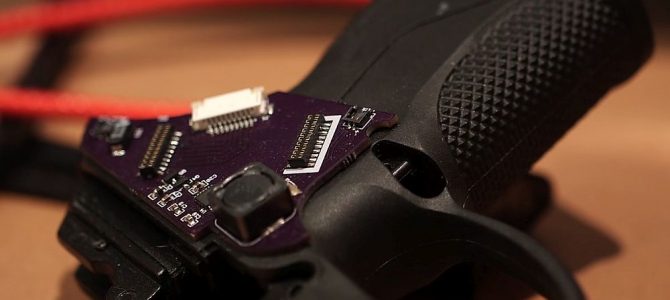
The New York Times has a problem with guns. The problem is both personal and professional, namely: the fellows who run the Times do not know all that much about guns, and they do not care to take any steps to learn about them.
The problem manifests itself heterogeneously: they cannot seem to get guns right no matter how they approach them. They do not understand concealed carry laws. They do not understand gun statistics. They do not understand assault weapons bans. They do not understand the rules of NRA conventions. They do not understand Australia’s gun control laws. They do not understand concealed carry demographics.
Add to this extensive list another thing about firearms the Times does not understand: smart guns.
In an editorial published this past Sunday, the Times asks: “Why Not Smart Guns in This High-Tech Era?” The paper’s editors, you see, think guns should be “equipped with fingerprint scanners, radio frequency chips or other evolving technology that blocks anyone but the owner from using them,” and they are frustrated that “gun-lobby politics and threats” are keeping smart guns off the market, thus causing untold numbers of murders and suicides.
This would indeed be very troubling—if it were true, or anything resembling true. In fact, the “gun lobby” does not oppose smart gun technology. For example, the NRA, in its own words, “doesn’t oppose the development of ‘smart’ guns, nor does it oppose the ability of Americans to voluntarily acquire them.” Only in a New York Times editorial could you construe an explicit statement from the National Rifle Association to mean the exact opposite of what it means.
The Times refuses to look deeper than the false boogeyman it has created out of the NRA. There are three reasons gun-owning Americans are suspicious of, and reluctant to purchase, “smart guns.” These reasons merit serious consideration, which is perhaps why anti-gun folks are so reluctant to consider them.
1. Smart Guns Are Impractical
The first is entirely utilitarian: smart guns as they exist today are wholly impractical. When I say “impractical,” I mean, “Not practical enough that you’d want to risk your safety buying it.”
Case in point: last November the NRA-published magazine America’s 1st Freedom reviewed the Armatix iP1, the widely hailed firearm that some consider to be the first feasible “smart gun” on the market. What did they find? In their own words, “a number of very serious problems,” namely: a chronic tendency to jam, “the worst double-action trigger [they’ve] ever tested,” an inability to safely thumb the hammer forward, a limited range of functionality due to the radio frequency mechanism to which the gun is paired, and a sky-high price tag (nearly $1,800).
Dryly, the reviewers note that they found the pistol “greatly wanting.” Do tell. If this is the finest the smart gun market has to offer thus far, no wonder nobody wants anything to do with it. Would you want to drop nearly $2,000 on an unsafe, semi-non-functional, inconvenient gun?
People who buy guns do so to ensure that they can keep themselves and those they care about safe. They are generally not willing to leave that safety up to this kind of chance, even if The New York Times really, really thinks they should.
2. If You Need a Gun, You Can’t Fiddle
But what if these kinks can be ironed out and a smart gun can function perfectly every time it needs to be fired? Still there are reasonable objections to this technology.
Smart guns generally operate by way of a radio frequency identification device (RFID): you must be wearing a special watch, or a ring, or some other trinket for the gun to operate. But what happens if the watch batteries fail? What happens if you lose the ring? What happens if the device is damaged? Your gun becomes an inert object, utterly useless to you and your family. Most gun owners do not want to have to keep track of an easily lost or easily damaged item in order to ensure their gun works.
Moreover, the basic premise of an RFID device renders a smart gun far less practical than a normal one. Presumably you will want to keep the radio device and gun separate so children or other unauthorized users cannot easily access the gun. Unless you’re wearing the RFID device all the time, this naturally means that, in a domestic emergency, you’ll have to scramble for the device before the gun can even work.
If there’s an intruder in your house threatening your children or your spouse, you don’t want to have to run across (or out of) the room to find a small object, then run back to the other side of the room (or another room entirely) to get the gun. No serious student of self-defense will want to waste precious seconds running around assembling far-flung parts to make a firearm work.
The same time crunch applies to “fingerprint scanning,” as well: think of how often your iPhone fails to read your fingerprint properly. Would you want the same unreliable technology if your life were at stake?
3. The Danger of Giving Power to Control Freaks
Yet even if a smart gun owner is willing to sacrifice safety for a small sense of security, there is a third issue to consider, and it is the most troubling: the threat that, once smart gun technology becomes widespread, the government will mandate that all guns must be “smart.” This is not a conspiracy theory or even a simple academic exercise: it’s already the case in New Jersey.
This is a deeply concerning proposal. Not only would government-mandated smart gun technology make American firearms prohibitively expensive (thus denying the poor a valuable option for self-defense), but there is a chance the technology could be used against gun-owning Americans themselves. Criminals or mass shooters could theoretically scan a public area to determine who has a gun and thus whom to shoot first. They could also scan individual houses to see which contain firearms (thus giving the criminals advanced warning of the presence of a firearm) or who doesn’t (thus marking the house as an easy target).
Also, as the NRA itself confirmed, the iP1 features a “kill switch” that “[allows] it to be disabled by third parties.” Got that? Whoever owns an iP1 can have his handgun disabled remotely. Does that sound like a secure firearm to you?
Americans are wise to be mistrustful of smart gun technology. In its present state it is unreliable and expensive. Even if the technology improves, however, it is still intrinsically a risky and fraught choice for self-defense. Yet The New York Times editorial board cannot figure out why nobody wants to buy these guns. Perhaps they should try talking to some real gun owners in order to find out. But why would they start now?









